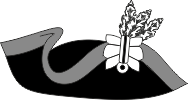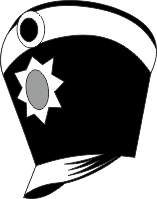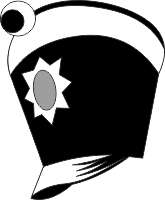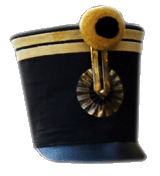mobile View, to the German Version tap the flag


• History
• Samples
• The French cockade
• The Italian coackde
• The Saxon cockade
A cockade is a colored badge, especially for caps of soldiers and officials. A cockade displays – mostly in concentric circles – the lokal or national colors. It is not a sovereign sign in the narrower sense, but it characterizes the bearer of the cockade as acting as a sovereign. For soldiers applies: the cockade characterizes the soldier as a regular warrior (combatant). A combatant is a person who is legitimated to fight with a weapon following the international law. For these persons applies in the moment of their capture, the provisions of the 3rd Geneva Convention from 12th of August in 1949 about the treatment as prisoners of war. In previous civil wars large cockades were sometimes worn on the civilian clothes of the fighters, to enable in the fray the recognition of belonging to the enemy or the own side. The coloring of the cockade is correctly described from the inside to the outside. The arrangement/sequence of the colors on the flag does not matter in this way.
At the end of the 18th and on the beginning of the 19th century, the shape of the cockades on the headgears changed in practically all armies in Europe and North America. For the moment there were still worn threecornered cocked hats (up to ca. 1786), which often showed a cockade of ribbon, a single-coloured, gathered, textile strip.

Threecornered cocked hat with cockade of ribbon
From about 1786 came up, the cockade came up cocked hats, which sometimes still showed a normal cockade of ribbon, but mostly round cockades of ribbon. These were textile discs, which were gathered and sewn, and were also concentrically arranged in different sizes and colours.

Cocked hat with cockade of ribbon

Cocked hat with round cockade of ribbon
From about 1806/1807 came up the shako, which showed multi-colored round disc-cockades, disks made from metal and dyed, which were arranged concentric and in different sizes and colors.

Shako with disk-cockade
One special shape of a cockade was the single or multi-coloured wool pom-pom (bobble), which were fixed on the top and on the front of the shako.

Shako with wool pom-pom
Of course there were other special military headgears, e.g. grenadier caps, fur caps, busby fur caps or crested helmets.
The colors of the cockades of ribbon mostly showed only one color. e.g. Black = Great Britain, USA, Prussia and many other German states, White = (royal) France, red = Spain etc. In the Napoleonic period, the new disc-shaped cockade was predominantly kept in the national colours.
The round cockades of ribbon and the metal disc-cockades were usually worn on the headgear, usually on the front and in the middle of the cap. Round cockades of ribbon, however, could also be worn on civilian clothes in civil wars in which there were no uniforms.
The metal disc-cockades were fixed in the same way on hoods or helmets, on pimple hoods they could also be screwed on the sides, where the chin strap is fixed. On the left and on the right side, the cockades could be different, e.g. colors of the empire and colors of the country. The today's textile cockades are usually completely embroidered and then sewn on the cap, or embossed and colored as a metallic cap badge.
A special form are airplane cocards (aircraft roundels), which however can appear considerable differently from the usual country cockades in design (colors, form and model).

three-coloured cockades:




two-coloured cockades:




single-coloured cockades:



An oval cockade is called a "National":

ca. 1813/1814, Austrian round cockade of ribbon in black/gold, above a wool pom-pom in the same colours:

Quelle/Source: Jürgen Kaltschmitt, Volker Preuß

The origin of the French cockade
The French cockade was – like the naval and war flag, and also the trade flag for royal ships – single-coloured white. White was the royal color of the Bourbons, who ruled over France from 1594 to 1792. The color combination of blue, white and red as the colors of France has its origin in the French revolution of 1789, when blue and red, the colors of the city of Paris, had been combined with the previous white. On the flags this was visible from 1790, and the today's known French flag was introduced in 1794. Presumably there were already blue-red cockades for Paris, and these were simply put on the royal white cockade. Thus a blue-red-white cockade was created as a capstick.





In the years 1804-1805, the cockade was officially changed in blue-white-red, which could not be fully achieved, because the old and experienced soldiers preferred to keep the old cockade, with the intention to distinguish themselves from the inexperienced newcomers with the new cockade.

The after revolution and the era of Napoleon following defeat of France, the Bourbon monarchy was restored in 1814, and the old monochrome white cockades were introduced again as capsticks. After the revolution of 1830, Louis-Philippe, the Duke of Orleans, became "civil king", and they remembered the color combination of blue, white and red, and the blue-white-red flags and cockades were reintroduced an keeped valid until today.
Quelle/Source: Jürgen Kaltschmitt, Volker Preuß

The origin of the Italian cockade
Already in November 1794 – as a result of the French Revolution and encouraged by the rise of the by Bonaparte commanded French revolutionary troops – rebellious students in Bologna and Milan had created as a distinguishing sign a green-red-red cockade. Ultimately, the colours of the city -white and red- (so in Bologna, Milan and other northern Italian cities) were added by green, as the color of good sense. But Green was not only the color of good sense, but also Napoleon's favorite color. Even in Italy, he had clothed his bodyguards on horseback (the Guids of the Consul) in green and as the Guids then became the hunters on horseback of the imperial guard, they wore green hussar dolmans. Even the by Bonaparte hisself weared uniform was green: the smaller uniform of a colonel of the guard hunters on horseback.





In the years 1804-1805, the cockade was officially changed in green-white-red, which could not be fully achieved (in the same way like in France itself), because the old and experienced soldiers preferred to keep the old cockade, with the intention to distinguish themselves from the inexperienced newcomers with the new cockade.

After the era of Napoléon , the Italian national state was abolished in 1814/1815 – on the occasion of the Congress of Vienna – and the conditions of the pre-Napoleonic period were restored. In the national revolution of 1848/1849, the color combination of green, white and red were remembered again. However, the state of Italy did not arise again until the years 1860/1861, and the green-white-red flags and cockades were reintroduced an keeped valid until today.
Quelle/Source: Jürgen Kaltschmitt, Volker Preuß

The origin of the Saxon cockade and the Saxon colours
In October 1813 nearly the whole army of the Kingdom of Saxony deserts to the Allies. The country becomes gradually occupied by Russian and Prussian troops. Because the Saxon king (and Duke of Warsaw) still maintains in the alliance with Napoléon, there is a real danger that the Kingdom of Saxony will disappear from the map, and possibly be divided between Prussia, Austria and Russia. The King of Prussia wants to have Saxony all to himself, and is really shure to take it over. The castle of Stolzenfels, given from the town of Koblenz to the King of Prussia, which was renovated and rebuilt from 1823 to 1847, shows in the decoration oftenly the coat of arms of Saxony, just to renew or at least to preserve the claim on Saxony. Saxon politicians and officers now wanted to appeal to the Saxon patriotism (embedded in the confession to the German fatherland), to mobilize the army, the newly established Landwehr, the new unit "Banner of the Voluntary Saxons", indeed the entire Saxon nation, as allies against Napoléon. A kingdom of Saxony, which was energetically involved in the liberation of Germany, will be treated more gloriously as a former ally of the enemy than a passive country waiting for its king.

1744–1813, Saxon cockade
The cockade of the troops of the Kingdom of Saxony (and from 1807 of the Duchy of Warsaw too) has been single-colored white since 1744. After the Battle of Leipzig (16th to 19th of October in 1813) Saxony became occupied – as a former ally of Napoleon, and it was formed the General Government of Saxony, which included Saxony-Altenburg and the Principalities of Reuss. As Governor General was installed the Russian Prince Nikolai Repnin-Volkonsky Grigojewitsch. Even in 1813 was proposed from the Saxon side (and approved by the Governor General), to replace the existing white cockades by a new cockade. Thus the general of the infantry von Thielmann announced in Leipzig on November 12th in 1813 that the Saxonian cockade is from now on green. This change was approved by the Russian Emperor. Than thanks to the liberation of Saxony, the green cockade was wrapped in gold (or orange/ yellow) and black, the colors of the Russian empire and of the cockades of its soldiers.

Russian cockade





The new cockade showed now the colors green, black and yellow, all colors taken from the Saxon coat of arms. Black and yellow are – probably not quite by chance – the national colors, and green is the color of the rhombus wreath.
The troop contingents of the Duchy of Warsaw remained loyal to Napoléon for patriotic reasons even after 1813, because they owed him the existence of the newly re-created Polish state "Duchy of Warsaw". The old Kingdom of Poland had been extinguished in 1795 by division. The Duke of Warsaw was King Frederick Augustus of Saxony, but after 1813 he was severely beaten and unable to act.
With the new cockade they could get three points: 1. distinguishing from the troops of the Duchy of Warsaw (no more white); 2. setting of an optical signal for the Saxon patriotism (colors of the Saxon coat of arms); 3. lean on the Russian liberators and occupiers, whose benevolence was vital for Saxony.
On the other hand, the newly recruited soldiers of the Landwehr, of the "Banner" and also of other units (e.g. the train battalion, founded in 1812) seem to have used Russian cockades, in an black-orange version, called "great" imperial-russian military cockade, and to have supplemented them with green in the middle. Black and orange are the colors of Saint George.





At the end of 1813 and beginning of 1814, the Saxon army was reorganized, the Landwehr became re-established and the unit "Banner of the Voluntary Saxons" was set up. The "Banner" became directly subordinated to the imperial Russian guard. The spring campaign is about to happen and it is not much time, so that not all units can be labeled according to the new regulation. The older and more experienced soldiers, who were reactivated for the service in the armed forces, but also veteran veterans at the "Banner of the Voluntary Saxons" kept their white cockades and fixed in the middle (perhaps for reasons of economy) only a reduced version of the new green- Black-yellow cockade.

from 1813/1814, variant of the Saxon cockade
However, eyewitnesses report frequently about color deviations during the implementation of the colors of the new cockade. Thus the "Elberfelder Bilderhandschrift". It shows the cockades of the Saxon soldiers mostly in green-black-yellow, but there are also exceptions. Presumably reasoned in war, its circumstances and the lack of material. It is obvious that they took what there was available and looked Saxon, somehow. There may also have been special regulations.

variant of the Saxon cockade,
1. "Banner of the Volunteers of Saxony",
2. Saxon artilleryman and Saxon infantryman of the "King" Regiment
Quelle/Source: Elberfelder Bilderhandschrift, fig. 25 c, fig. 47 a+c

variant of the Saxon cockade,
Saxon infantryman
Quelle/Source: Elberfelder Bilderhandschrift, fig. 28 c

variant of the Saxon cockade,
1. Saxon Train Soldier,
2. Saxon infantryman of the "Prince Anton" Regiment
Quelle/Source: Elberfelder Bilderhandschrift, fig. 11 d, fig. 48 a
After all, yellow and blue were the house colors of the house of Wettin, the Saxon dynasty! A mixup with Sweden is, however, impossible, since the uniforms are clearly Saxon. The Swedish Army did not introduce its yellow-blue national cockade until January 1st in 1814, and until this point the soldiers beared cockades with the colors of their regiments.

from 1813, Saxon cockade
The Congress of Vienna had decided at the beginning of 1815 that Saxony had to cede half of its territory of Prussia, and not only that. The army became also divided. A share of 46% of the staff was also to cede to Prussia, and these soldiers were to take an oath to the Prussian king, although they had not yet been released from their oath to their Saxon king. This, as well as the bad treatment by the Prussians, led to a partial mutiny among the Saxons on May 2nd in Liège, and already on the next day, the seven leaders of the revolt were shot by the order of General Field Marshal von Blücher and the troop's banner of the 1st Guard Battalion should have been burned. However, the centerpiece of the flag with the royal monogram "FA" could be brought to safety by Saxon officers – with the knowledge and approval of Prussian officers, especially by General von Borstell. Only the remainders of the flag were burned. Borstell was sentenced to prison in a fortress for one year, but he did not have to spent the complete time there.
When the Saxon King Friedrich August I., of the dynasty of the Albertine Wettins, in May 1815 was returning home from captivity to Saxony after the end of the liberation wars against Napoleon, he instructed Lieutenant General of Lecoq at the 22nd of May in 1815, to reorganize and bring home, the at the River Rhine standing Saxon troops. The there until this point in time still white cockades on the caps of the soldiers were to surround with a green edge by this instruction of the king to avoid confusions with other troops. The news about the creation of the color combination of white and green spread very quickly, and arrived Saxony before the king. So he was received by his people with white and green garlands, flags and ribbons. In recognition of this fact, the monarch decided on 16th of June in 1815 to take over the white-green cockade for national cockade. That was the birth of the white and green as the colors of Saxony. The Saxon duchies (Thuringia), ruled by the Ernestine Wettins took mostly over these arrangements for their colors and flags.
Quelle/Source: Jürgen Kaltschmitt, Volker Preuß, Wikipedia (DE)


![]()




































